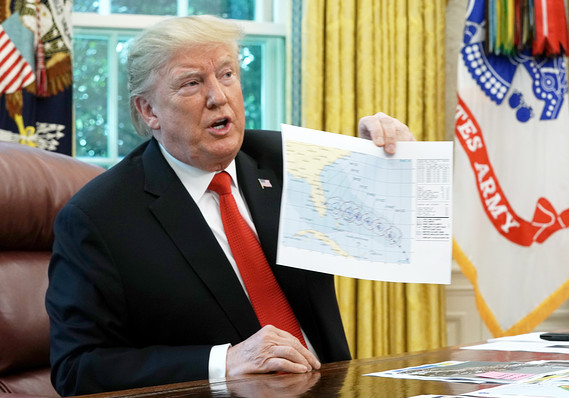 Getty Images
Getty Images We don’t yet know how Democrats will run against President Donald Trump’s economic record. But we know exactly, after Friday’s jobs report, how Donald Trump would run against it.
That’s the cleanest political-economic takeaway from the news that the economy added just 130,000 jobs in August, about 40,000 short of expectations and undermined further by weak details in the report.
For investors, the slow growth pretty clearly means that interest rates are coming down again when the Federal Reserve meets later this month, unless Fed Chair Jay Powell wants to be as stubborn as the man who appointed and now bad-mouths him.
But the juicy part for the majority of the country that disdains Trump may be that the economy, slowed by a drop in exports (especially to China) looks so much like what was going on as he prepared to run in 2015.
With the key difference that this president set out to make that slowdown happen.
“Whom the gods would destroy they first make mad,” the poet Henry Wadsworth Longfellow wrote in 1875. And people are saying — in The New Yorker and elsewhere — that the president spent August acting even more bonkers than usual, right down to spending a week arguing over whether Hurricane Dorian was ever going to hit Alabama.
There are two reasons the jobs number is worse than it looks.
Number one, discount it for the fact that it includes 25,000 Census takers hired for next year’s count. Those jobs disappear in a year. Private-sector growth was just 96,000. And number two, discount it more because June and July job growth was revised lower by 20,000.
So it’s not a stretch to say this 130,000-job month was really more like 85,000, which is really pretty poor. Wage growth, at 3.2% over the last year before inflation, is about on its recent pace. The unemployment rate stayed at 3.7%.
“The slowdown is real but fears of a recession are overblown,” Upwork.com chief economist Adam Ozimek said on Twitter. “The bad news this month is that job growth is below what the economy could be generating right now given a labor market that is still well short of full employment. The good news, these numbers don’t provide evidence that we are entering a recession.”
So your money is in not much worse shape than it was before Trump started his trade war — a conclusion bolstered by the fact that the Standard & Poor’s 500 SPX, +0.04% , for all the turmoil recently, has still returned 3.03% (including dividends) in the last year, buffeted between a brief bear market last fall and a 19% gain this year.
The stats sound increasingly like the summer of 2015 through early 2016, now that we think about it.
In August 2015, the economy added 122,000 jobs, a pace that would jump to 339,000 by October before falling to just 15,000 in May 2016, when a strike at Verizon Communications VZ, +0.25% temporarily cut 35,000 jobs.
The economy then was on pace to grow 2.9% in 2015 and 1.6% in 2016, and stocks were stagnant for 2015 and parts of 2016, beginning to rise in February in a move Trump, who was elected in November, has claimed credit for repeatedly.
Looking at that economy, here’s what Trump said.
“Right now, under Obama-Clinton policies, the economy grew only 1.1% last quarter – that translates to millions of lost jobs,” Trump told the New York Economic Club in September 2016. “This is the weakest so-called recovery since the Great Depression. Over the last seven years, the economy grew only 2.1%, the slowest period in 70 years.”
Well, most estimates of second-half growth now are running between 1.5%, and 2% for this year, after a 2% annualized climb in the second quarter. So the year, including a relatively big first quarter, may come in around 2.4%, the same as in 2017. The S&P is all but flat for the last year, and the Dow Jones Industrial Average DJIA, +0.23% is almost exactly where it was in January 2018.
As in early 2016, the manufacturing sector, export-led as it is, is heading into a recession. Back then, manufacturing’s slowdown didn’t tip the broader economy into recession, and it doesn’t seem likely now, either.
Politically, though, Trump’s economy is vulnerable to the same attacks he launched on Obama’s — it’s largely the same economy. But there’s one big difference.
Today, the drag from trade is bigger than in 2015-16. And President Barack Obama didn’t create “his” export drag by trying to crimp trade — China’s demand issues then were about markets growing skeptical of slowing growth and its debt load.
Trump has made no bones about trying to squeeze China’s growth to get trade concessions — and it has backfired, hurting exporters like Boeing BA, +0.76% and companies like General GM, +0.05% hat import stuff (steel, in GM’s case) whose price has risen because of tariffs.
Every election is partly about the economy — how it’s doing, and whom we trust to guide it. Today’s jobs report is one more sign that, even if he hasn’t done long-term harm amid his odd summer semi-meltdown, the president is falling well short of his boast that only he could fix it.










Add Comment